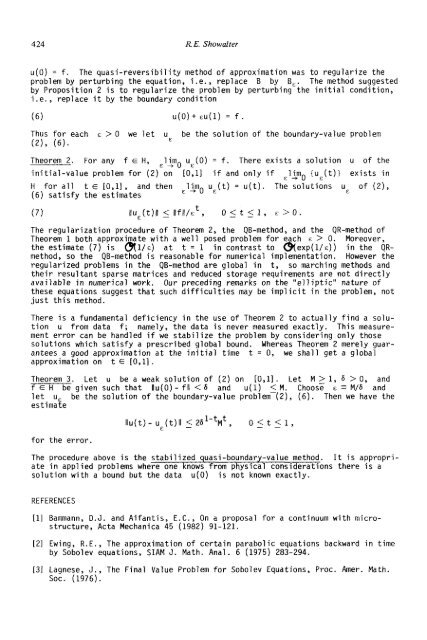r < t - Department of Mathematics
r < t - Department of Mathematics
r < t - Department of Mathematics
You also want an ePaper? Increase the reach of your titles
YUMPU automatically turns print PDFs into web optimized ePapers that Google loves.
424 R. E. Showalter<br />
u(0) = f. The quasi-reversibility method <strong>of</strong> approximation was to regularize the<br />
problem by perturbing the equation, i.e., replace B by B,. The method suggested<br />
by Proposition 2 is to regularize the problem by perturbing the initial condition,<br />
i.e., replace it by the boundary condition<br />
(6) u(O)+ EU(1) = f.<br />
Thus for each E >O we let uE be the solution <strong>of</strong> the boundary-value problem<br />
(21, (6).<br />
Theorem 2. For any f E ti, l ~ m u,(O) 0 = f. There exists a solution u <strong>of</strong> the<br />
initial-value problem for (2) on [0,1] if and only if ,l-i+m~~ {uE(t)I exists in<br />
ti for all t E [0,11, and then ,li+!mo u,(t) = u(t). The solutions uE <strong>of</strong> (Z),<br />
(6) satisfy the estimates<br />
(7) tlUE(t)ll 5 Ilfll/Et, 0 5 t 5 1, € > 0.<br />
The regularization procedure <strong>of</strong> Theorem 2, the QB-method, and the QR-method <strong>of</strong><br />
Theorem 1 both approximate with a well posed problem for each E > 0. Moreover,<br />
the estimate (7) is a 1 / ~ ) at t = 1 in contrast to (9lexp(l/E)) in the QRmethod,<br />
so the QB-method is reasonable for numerical implementation. However the<br />
regularized problems in the QB-method are global in t, so marching methods and<br />
their resultant sparse matrices and reduced storage requirements are not directly<br />
available in numerical work. Our preceding remarks on the "elliptic" nature <strong>of</strong><br />
these equations suggest that such difficulties may be implicit in the problem, not<br />
just this method.<br />
There is a fundamental deficiency in the use <strong>of</strong> Theorem 2 to actually find a solution<br />
u from data f; namely, the data is never measured exactly. This measurement<br />
error can be handled if we stabilize the problem by considering only those<br />
solutions which satisfy a prescribed global bound. Whereas Theorem 2 merely guarantees<br />
a good approximation at the initial time t = 0, we shall get a global<br />
approximation on t E [O,l].<br />
Theorem 3, Let u be a weak solution <strong>of</strong> (2) on [0,11. Let M 2 1, 6 > 0, and<br />
f E ti be given such that Ilu(0) - fll < 6 and u(1) 5 M. Choose E M/S and<br />
let uE be the solution <strong>of</strong> the boundary-value problem (Z), (6).<br />
estimate<br />
Then we have the<br />
for the error.<br />
The procedure above is the stabilized quasi-boundary-value method. It is appropriate<br />
in applied problems where one knows from physical considerations there is a<br />
solution with a bound but the data u(0) is not known exactly.<br />
REFERENCES<br />
[l] Bammann, 0.3. and Aifantis, E.C., On a proposal for a continuum with microstructure,<br />
Acta Mechanica 45 (1982) 91-121.<br />
[21 Ewing, R.E.<br />
by Sobolev<br />
[31 Lagnese, J<br />
SOC. (1976<br />
, The approximation <strong>of</strong> certain parabolic equations backward in time<br />
equations, SIAM J. Math. Anal. 6 (1975) 283-294.<br />
, The Final Value Problem for Sobolev Equations, Proc. her. Math.

















